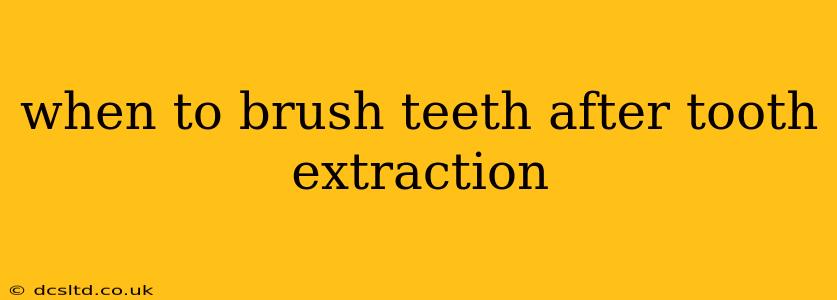Losing a tooth is a significant event, and knowing how to care for your mouth afterward is crucial for proper healing and preventing complications. One of the most frequently asked questions revolves around brushing your teeth after an extraction. The answer isn't a simple "wait 24 hours," as the best approach depends on several factors. This guide will provide a detailed explanation, answering common questions to help you navigate this important post-operative period.
How Soon Can I Brush My Teeth After a Tooth Extraction?
The short answer is: gently as soon as you feel comfortable, usually after the initial numbness wears off. However, it's crucial to avoid disturbing the extraction site directly. Your dentist or oral surgeon will provide specific post-operative instructions, which you should follow meticulously. Generally, you'll be advised to wait a few hours to allow the blood clot to form, but you can resume gentle brushing of the rest of your teeth.
What if I Have Stitches After a Tooth Extraction?
If you have stitches, extra caution is necessary. You'll want to avoid directly brushing the area with stitches. Focus on brushing gently around the extraction site, ensuring you don't disturb the stitches. Your dentist will advise you on when the stitches will be removed and when you can resume normal brushing.
Can I Use Mouthwash After a Tooth Extraction?
Rinsing your mouth gently with salt water (a half-teaspoon of salt dissolved in a glass of warm water) is generally recommended several times a day starting the day after the extraction. This helps keep the area clean and promotes healing. However, avoid vigorous rinsing, which could dislodge the blood clot. Your dentist may also recommend a specific mouthwash; always follow their instructions. Do not use alcohol-based mouthwashes as these can irritate the healing wound.
How Should I Brush My Teeth After a Tooth Extraction?
Gentle brushing is key. Use a soft-bristled toothbrush and avoid scrubbing vigorously. Focus on brushing the areas surrounding the extraction site, avoiding direct contact as much as possible. A soft-bristled toothbrush minimizes irritation and the risk of dislodging the blood clot.
What Happens if the Blood Clot is Dislodged?
A blood clot is essential for proper healing after a tooth extraction. If the blood clot is dislodged (a condition called dry socket), it can lead to significant pain, infection, and delayed healing. Symptoms of a dry socket include intense pain, a foul odor, and a visible empty socket. If you suspect a dry socket, contact your dentist immediately.
When Can I Resume Normal Brushing?
Once the extraction site has begun to heal significantly (typically after a week, or as directed by your dentist), you can gradually resume normal brushing techniques. However, always be gentle in the area of the extraction.
What Type of Toothbrush Should I Use?
A soft-bristled toothbrush is always recommended after a tooth extraction. The soft bristles will minimize trauma to the sensitive gums and healing extraction site. Avoid using hard-bristled brushes, which can be abrasive and disruptive to the healing process.
Should I Avoid Brushing Completely After Tooth Extraction?
No, avoiding brushing altogether is not recommended. Maintaining good oral hygiene in the areas that are not directly affected by the extraction is crucial to prevent infection and maintain overall oral health. Focus on gentle brushing and avoid the extraction site.
This guide provides general advice, but your dentist's instructions always take precedence. Following your dentist’s personalized post-operative care plan is the best way to ensure proper healing and minimize complications after a tooth extraction. Remember, open communication with your dentist is key to a successful recovery.
